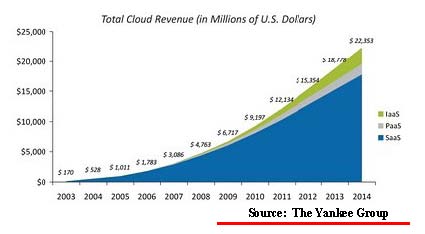Delivering Cloud Services by Satellite
by Bruce Elbert
Unlike telephone networks which traditionally provided analog pipes geared to the human voice, satellite links established the digital mode of communications well in advance of the Internet era. With digital TV and broadband data now dominant in satellite bandwidth usage, we are at a point to address some of the newer and more challenging demands of corporations and government agencies for better access to information and computing resources. This is how we arrive at “cloud computing,” a new buzz word that contains a bit of a mixed message.
At Satellite 2011, held in Washington, D.C. in mid-March, the World Teleport Association sponsored a panel on this very topic. Joining me were Steve Hart, Co-Founder and CTO of ViaSat, Glenn Katz, President and COO of Spacenet, Greg Pelton, Sr. Director and GM of Cisco IRIS, Steve Yablonski, CVP & CTO of Globecomm, and Serge Van Herck. CEO of Newtec N.V. These industry veterans and the excellent companies they represent provided a lot of insight into the strengths and weaknesses that satellite technology has in its ability to provide access to the cloud and to facilitate a set of valuable services to organizations and end users.
Cloud computing would appear to combine computing with a broad grid of data communications; in particular, the grid is supplied by the global Internet. According to Dublin-based Research and Markets, the genre of cloud computing may be defined as follows:
“…Cloud computing delivers software, platform, and IT infrastructure services via a shared network. In this model, businesses access resources such as hosted software and applications remotely, i.e., via the Internet. The model not only obviates the need for making capital investments in servers and storage, but also results in zero operational expenses for running data centers. Cloud computing not only reduces business costs, but also makes applications accessible from any location, and reacts swiftly to changes in business needs...”
Research and Markets goes on to delineate three acronyms: Infrastructure as a service (IaaS), Platform as a service (PaaS), and Software as a service (SaaS). They have estimated that SaaS is currently the leader of this pack, accounting for 73% of the market's 2010 revenues of $37.8 billion. Leading providers of SaaS are Adobe Web Connect, Google, Cisco WebEx, and Yahoo; however, there are literally thousands of smaller players who provide SaaS related to very specific industries and even professions. Big as well as small business users are already benefiting from SaaS.
service (SaaS). They have estimated that SaaS is currently the leader of this pack, accounting for 73% of the market's 2010 revenues of $37.8 billion. Leading providers of SaaS are Adobe Web Connect, Google, Cisco WebEx, and Yahoo; however, there are literally thousands of smaller players who provide SaaS related to very specific industries and even professions. Big as well as small business users are already benefiting from SaaS.
The Cloud from a Satellite Perspective
Most of us look up to see a cloud, but a geostationary satellite must, by necessity, look down. Our panel of experts provided that view from 22,000 miles above to illuminate the broad expanse of cloud computing and within the “weeds” that present many technical and cultural issues faced by potential users and service providers. The basic precept was expressed by Steve Hart: the issues involved in being an effective transport for data, regarding especially latency, bandwidth, security and how these interact with application acceleration. Taking latency and bandwidth first, the panel recognized the truism that satellite links deliver good bandwidth, especially in a point-to-multipoint mode. Latency, on the other hand, tends to besatellite technology’s Achilles heel due to the large but constant single-hop delay of a quarter of a second. Auspiciously, the majority of applications offered via SaaS are not real-time but rather capabilities that rely upon servers and databases. Since most of the latency is due to processing and database look-up, satellite delay can be rendered secondary to the overall user experience.
Security may be another matter; satellite links are broadcast across a wide area and are easily intercepted. Likewise, access to a satellite can be denied when there is radio frequency interference (RFI), both unintentional and intentional. It is easy enough to provide telecommunications security using various forms of encryption. Preventing the jamming produced by interference is something not easily done on an individual user basis. Rather, RFI is controlled through aggressive policing by satellite operators and governments, along with an industry that provides tools to reduce the time that interference goes unchecked. The broadcasting and VSAT segments are making great strides in this area and it won’t be much longer before at least the unintentional variety of RFI is reduced to an occasional inconvenience (i.e., within a typical availability objective of 99.95%).
Greg Pelton addressed the multiplicity of standards found among satellite equipment manufacturers and operators. Coming from the Internet domain, Greg expressed the view that such diversity impedes the growth of the cloud via satellite. Newtec’s Serge Van Herck offered that standards can be less of an issue if the satellite technology provides a complete end-to-end solution, something that his company and others are actively doing. Steve Yablonski took this in the direction of saying that the necessary standard is found in the network to be served or accessed. He mentioned a network provided by Globecomm where satellite is the primary and terrestrial is backup. But, both interface in the same standard.
All agreed the one standard that is having a very favorable impact on the bandwidth side is DVB-S2, a system that provides the most advanced modulation and coding techniques currently available to the broad market. However, the real benefit to the cloud could be from an adjunct to DVB-S2 called Adaptive Coding and Modulation (ACM). Several VSAT manufacturers, including the companies represented in our panel, Newtec and Spacenet, introduced ACM into their networks. It allows an operator/user to provide near 100% service availability in the presence of link disruptions like rain attenuation and limited shadowing. There is a tradeoff in that the actual throughput would drop during the recovery process; however, most Internet applications are accustomed to variable data rate and so could be expected to “power through.”
Where is Satellite Ahead in the Cloud?
Satellite access to the cloud brings with it a form of flexibility not available on terrestrial networks. Steve Hart feels that this opens up a big opportunity for satellite, especially with high-bandwidth satellites like ViaSat 1 and KA-SAT. Spacenet’s Glenn Katz added that a properly-engineered satellite resource literally goes above and beyond terrestrial for a 100% reliable network through careful merging of these media. Diversity of path, after all, is the most prevalent way to meet the goal of five nines, i.e. 99.999% reliability.
Satellite networks can play in the two principal domains of cloud computing: public clouds and private clouds. Cisco’s Greg Pelton suggested that the current thrust of major corporations and government agencies is for private cloud computing. The space resource for this could be a dedicated satellite, such as what the US Department of Defense is re-creating through Wideband Global Satcom (WGS) and other programs, and shared satellite bandwidth, which is the domain of major satellite operators Intelsat, SES and Eutelsat.
Greg Pelton mentioned that Cisco launched a program called Internet Routing in Space (IRIS), which is currently flying on Intelsat 14 and covering C and Ku-bands throughout the Atlantic Region. Their partner, TCS, provides satellite-hubbed IP routing over the largest footprint every created for broadband data. It will be interesting to follow IRIS as services and applications ramp up. This could be the space Internet infrastructure that makes cloud computing into a pervasive resource for half of the world’s population. Intelsat is in the process of building new satel-lites and enhancing fiber-based resources globally to support cloud computing and other data communications applications.
Serge Van Herck reflected on how satellites and cloud computing combine like a power grid to allow users to engage in IaaS, PaaS and SaaS, “without knowing IT”. As defined by Research and Markets, making applications accessible from any location, and reacting swiftly to changes in business needs.
-------------------------------------
 Bruce Elbert has over 30 years of experience in satellite communications and is the President of Application Technology Strategy, Inc., which assists satellite operators, network providers and users in the public and private sectors. He is an author and educator in these fields, having produced seven titles and conducted technical and business training around the world. During 25 years with Hughes Electronics, he directed major technical projects and led business activities in the U.S. and overseas. He is the author of The Satellite Communication Applications Handbook, second edition (Artech House, 2004). web : www.applicationstrategy.com/ email: bruce@applicationstrategy.com
Bruce Elbert has over 30 years of experience in satellite communications and is the President of Application Technology Strategy, Inc., which assists satellite operators, network providers and users in the public and private sectors. He is an author and educator in these fields, having produced seven titles and conducted technical and business training around the world. During 25 years with Hughes Electronics, he directed major technical projects and led business activities in the U.S. and overseas. He is the author of The Satellite Communication Applications Handbook, second edition (Artech House, 2004). web : www.applicationstrategy.com/ email: bruce@applicationstrategy.com






